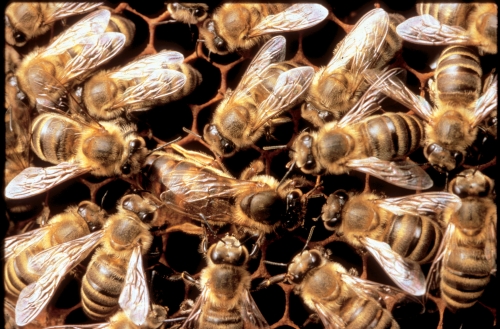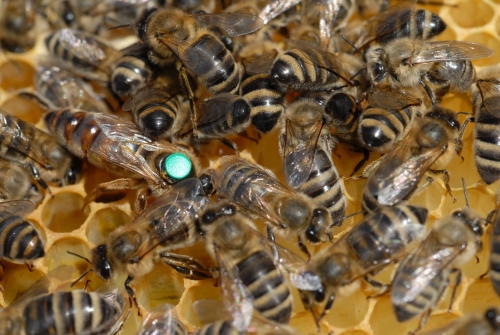- Author: Kathy Keatley Garvey
We’re outnumbered.
Plain as day. And they’re not going away.
The estimated ratio of insects to humans is 200 million to one, say Iowa State University entomologists Larry Pedigo and Marlin Rice in their newly published (sixth edition) textbook, Entomology and Pest Management.
There's an average of 400 million insects per acre of land, they say.
400 million!
Per acre.
“The fact is, today’s human population is adrift in a sea of insects,” they write in their introduction.
Well, what about biomass? Surely we outweigh these critters?
No, we don't. The
There you go. The insects are the land owners; we are the tenants. “They are the chief consumers of plants; they are the major predators of plant eaters; they play a major role in decay of organic matter; and they serve as food for other kinds of animals,” Pedigo and Rice write.
The good: they give us honey and pollinate our crops. They spin our silk. They serve as natural enemies of pests. They provide food for wildlife (not to mention food for some of us humans). They are scavengers. They provide us with ideas for our art work. They are fodder for our horror movies.
And what scientist hasn't benefitted from the inheritance studies of the fruit fly, Drosophila melanogasta? What ecologist hasn't studied water pollution by examining the mayfly population? Mayflies are the counterpart of canaries in the coal mine.
The bad: they eat our food crops, forests and ornamental plants. They devour or spoil our stored grain. They chew holes in our clothing. They pester us. They annoy our animals, too.
The ugly: They can—and do—kill us. Think mosquitoes. Think malaria,
Ironically, despite the huge numbers of insects, many people don't know the meaning of the word, entomology, the science of insects. They should. Insects outnumber us and always will. They've lived on the earth longer than us (400 million years) and adapt to changes better than we do. Most are tiny. Most can fly. And most reproduce like there's no tomorrow.
"Based solely on numbers and biomass, insects are the most successful animals on earth," the authors claim.
You can't argue with that.
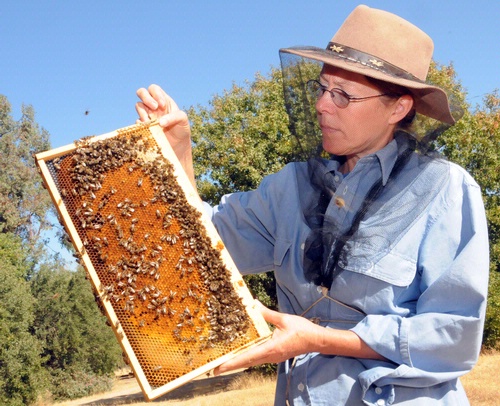
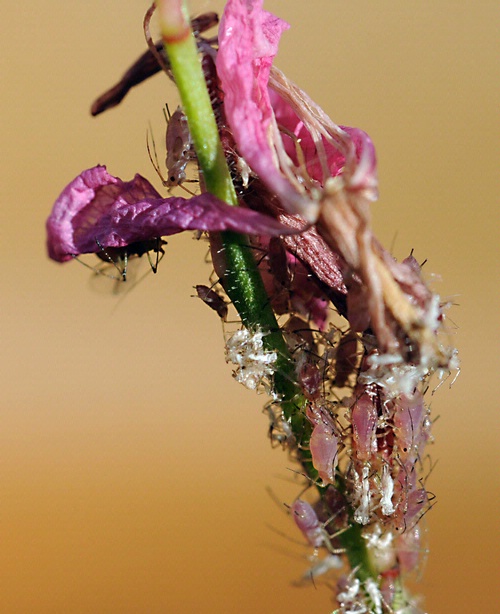
- Author: Kathy Keatley Garvey
Those dratted mites.
UC Davis entomologist Robbin Thorp, emeritus professor and a native bee pollinator specialist, sent us a BBC report linking a varroa mite infestation to a devastating honey production loss in the UK. It's the worst honey crisis ever to hit the UK.
In short: beekeepers are concerned that by Christmas, there may be no more domestically produced honey left on the supermarket shelves.
The mite infestation has already killed off an estimated quarter of the UK's honey bees, according to BBC correspondent Jeremy Cooke, who said about "one in three colonies has been wiped out."
The varroa mite, or the Varroa destructor, is a nasty pest. Now found in most countries (Australia is an exception), it's an external parasite initially discovered on the Asian honey bee, Apis cerana. Over the last few decades, however, it has spread to the Western honey bee (also known as the European honey bee), Apis mellifera.
The varroa mite entered the UK in 1992, reports show. It has since spread throughout England, Wales, Scotland and Northern Ireland.
The blood-sucking parasite feeds on both adults and the brood (immature larvae). It weakens the bees, opening them up to all sorts of diseases. And eventually, if not controlled, it will destroy the colonies.
The bad news is that the varroa mite cannot be completely eradicated, but with proper control methods, the mite population can be kept at a low level.
When California State Secretary of Agriculture A. G. Kawamura visited the Harry H. Laidlaw Jr. Honey Bee Research Facility at UC Davis last month, bee breeder-geneticist Susan Cobey showed him dead mites on a hive floor. (See story on UC Davis Department of Entomology site.)
Kawamura is no stranger to bees or bee pests. As a youth, he reared bees--until the infectious bee disease, American foulbrood, upset his plans.
To control the mite, beekeepers usually use a combination of management methods. They use biotechnical methods and chemical controls. Unfortunately, in some areas, the varroa mite is developing resistance to miticides--another worry for beekeepers.
Said Cobey: "You need to reduce mite levels in colonies by late summer--August/September--to have healthy bees in spring."
Cooperative Extension apiculturist Eric Mussen of UC Davis says that in California, the Department of Pesticide Regulation "is close to approving another chemical treatment" to help control the mite problem.
It may be ready by next spring.
The mites will be waiting.

- Author: Kathy Keatley Garvey
It's all about the bees.
When A. G. Kawamura, secretary of the California Department of Food and Agriculture, and the newly selected State Apiary Board meet from 10 a.m. to 4 p.m. on Friday, Oct. 3 at the Harry H. Laidlaw Jr. Honey Bee Research Facility, UC Davis, they'll talk about the troubled bee business, tour the facility, elect new officers, and listen to research presentations.
Members of the apiary board are all beekeepers. The five members represent the state's major geographical regions. They are Jackie Park-Burris of Palo Cedro, president of the California State Beekeepers' Association; Leroy Brant of Oakdale; Lyle Johnston of Madera; Steve Godlin of Visalia; and Richard Ashurst of Westmorland. They will each serve a four-year term. The UC Davis liaison is apiculturist Eric Mussen, member of the UC Davis Department of Entomology faculty and a Cooperative Extension bee specialist since 1976.
If there's ever been an industry under attack, it's the apiary industry. The bees are subjected to stress, parasites, diseases, pesticides, malnutrition, climate change, and that mysterious phenomonen known as colony collapse disorder (CCD), in which bees abandon their hives..
Meanwhile, the United States is facing its worst financial crisis since the Great Depression. The new "buzz words" include mortgage meltdowns, skyrocketing fuel prices, diving stocks, and crumbling financial institutions.
But there's another "buzz" that should grab our attention: the bees.
Honey bees pollinate about one-third of the food we eat. They pollinate more than 90 fruit, vegetable and nut crops, including apples, strawberries, cherries, peaches, cantaloupe, tomatoes, cucumbers, and almonds.
As state legislators agreed when they formed the apiary board: "A healthy and vibrant apiary industry is important to the economy and welfare of the state" and the industry's "promotion and protection is in the interest of the people of the state of Califonria."
It is indeed.
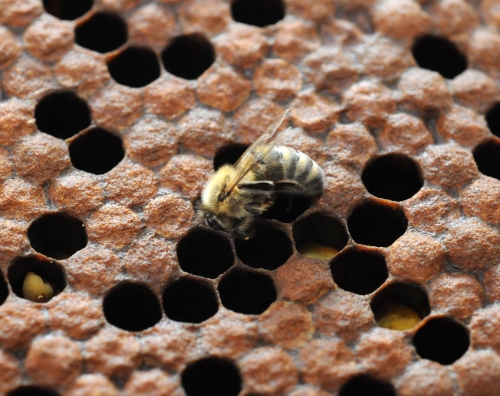
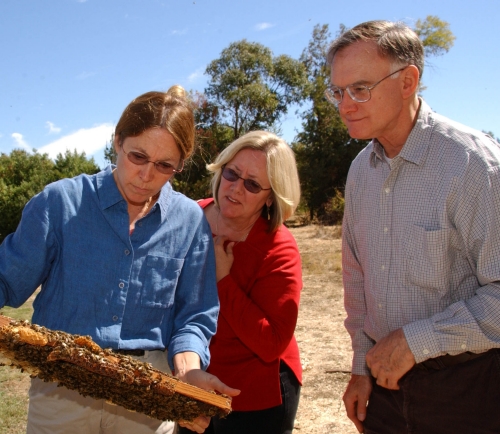
- Author: Kathy Keatley Garvey
It's tough being a drone honey bee this time of year.
The drones, or male bees, don't survive the winter.
Bee breeder-geneticist Susan Cobey of the Harry H. Laidlaw Jr. Honey Bee Research Facility at UC Davis admits to having a soft spot for drones. Once the honey-gathering season is over, the worker bees (sterile females) evict the drones from the hive, as the only function of the males is to mate.
“They're cold and hungry, sitting there on the doorstep and wanting to go back in. They're attacked and they die. Well, it's a matriarchal society.”
Throughout the spring, summer and early fall, drones routinely leave the hive in mid-afternoon on a mating expedition. Last Friday at the Laidlaw facility, the drones exited the hives around 3 p.m. They wobbled out of the hive and then took off. The plan? Head for "the drone congregration area," said UC Davis apiculturist Eric Mussen. Drones congregate not far from the hive and wait for a virgin queen bee to arrive.
The virgin queen mates with mulitple drones, often as many as 12 to 25, and then returns to her hive to lay eggs for the rest of her life. She never leaves the hive after her maiden flight. "She's an egg-laying machine," as Cobey says.
For the drones, it's a different story. They mate and then they die. And if they can't find a mate? With the onset of cold weather and winter, if they try to return to the hive, their sisters won't let them back in. They don't want the drones taxing their food supply.
Oh, brother, where art thou?
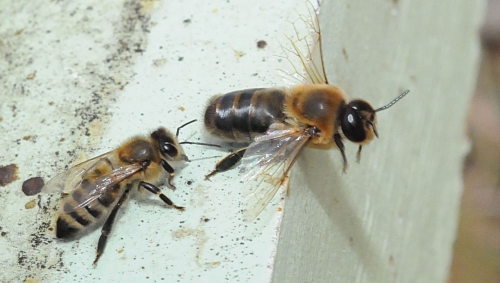
- Author: Kathy Keatley Garvey
If you were a queen bee, you'd be laying about 1500 to 2000 eggs today. It's your busy season.
"She's an egg-laying machine," said bee breeder-geneticist Susan Cobey of the Harry H. Laidlaw Jr. Honey Bee Research Facility at UC Davis. "And she's the mother of all the bees in the hive." During the peak season, that amounts to about 50,000 to 80,000 workers (sterile females) and 1000 to 2000 drones (males).
Worker bees take care of her every need. They feed her, groom her and protect her, Cobey said, "and then they have the additional tasks of rearing and feeding her young."
The queen bee is easy to spot in the hive; she's the biggest bee. And wherever she goes, you'll see her court (workers) surrounding her.
Beekeepers mark her with a colored dot on her thorax so she's easily visible. (School children, when asked to single out the queen bee, say "She's the one with the dot!")
On her maiden flight, the queen bee mates with some 12 to 25 drones and then she heads back to the hive to lay eggs for the rest of her life, "usually two or three years," said Cobey, who is internationally renowned for her classes on "The Art of Queen Rearing" and "Instrumental Insemination and Bee Breeding."
The queen bee destroys any and all competitors for her "throne" by stinging and killing them. Unlike worker bees, she does not die after she stings.
Interestingly enough, only female bees can sting. Drones, or male bees, have no stingers (despite what Jerry Seinfeld's character said in The Bee Movie). Their only purpose is to mate with the queen. Then they die.
It's a matriarchal society. The girls (worker bees) do all the work; they serve as nurses, guards, grocers, housekeepers, construction workers, royal attendants and undertakers. It's not surprising, then, that during the summer, their life span is only four to six weeks.
Meanwhile, if you're the queen bee, there's no reproductive rest for you! You have about 1,999 more eggs to lay today.
